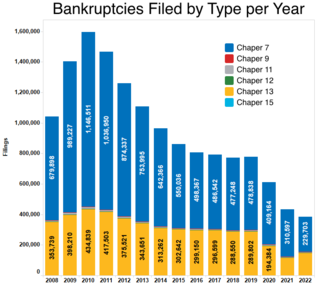Bankruptcy is a legal process through which people or other entities who cannot repay debts to creditors may seek relief from some or all of their debts. In most jurisdictions, bankruptcy is imposed by a court order, often initiated by the debtor.
Debt restructuring is a process that allows a private or public company or a sovereign entity facing cash flow problems and financial distress to reduce and renegotiate its delinquent debts to improve or restore liquidity so that it can continue its operations.

In the United States, bankruptcy is largely governed by federal law, commonly referred to as the "Bankruptcy Code" ("Code"). The United States Constitution authorizes Congress to enact "uniform Laws on the subject of Bankruptcies throughout the United States". Congress has exercised this authority several times since 1801, including through adoption of the Bankruptcy Reform Act of 1978, as amended, codified in Title 11 of the United States Code and the Bankruptcy Abuse Prevention and Consumer Protection Act of 2005 (BAPCPA).

In accounting, insolvency is the state of being unable to pay the debts, by a person or company (debtor), at maturity; those in a state of insolvency are said to be insolvent. There are two forms: cash-flow insolvency and balance-sheet insolvency.
Consumer bankruptcy in Canada is governed by the Bankruptcy and Insolvency Act ("BIA"). The legislation is complemented by regulations, as well as directives from the Office of the Superintendent of Bankruptcy that provide guidelines to trustees in bankruptcy on various aspects of the BIA.

The Bankruptcy and Insolvency Act is one of the statutes that regulates the law on bankruptcy and insolvency in Canada. It governs bankruptcies, consumer and commercial proposals, and receiverships in Canada.
As a legal concept, administration is a procedure under the insolvency laws of a number of common law jurisdictions, similar to bankruptcy in the United States. It functions as a rescue mechanism for insolvent entities and allows them to carry on running their business. The process – in the United Kingdom colloquially called being "under administration" – is an alternative to liquidation or may be a precursor to it. Administration is commenced by an administration order.

United Kingdom insolvency law regulates companies in the United Kingdom which are unable to repay their debts. While UK bankruptcy law concerns the rules for natural persons, the term insolvency is generally used for companies formed under the Companies Act 2006. Insolvency means being unable to pay debts. Since the Cork Report of 1982, the modern policy of UK insolvency law has been to attempt to rescue a company that is in difficulty, to minimise losses and fairly distribute the burdens between the community, employees, creditors and other stakeholders that result from enterprise failure. If a company cannot be saved it is liquidated, meaning that the assets are sold off to repay creditors according to their priority. The main sources of law include the Insolvency Act 1986, the Insolvency Rules 1986, the Company Directors Disqualification Act 1986, the Employment Rights Act 1996 Part XII, the EU Insolvency Regulation, and case law. Numerous other Acts, statutory instruments and cases relating to labour, banking, property and conflicts of laws also shape the subject.
The insolvency law of Switzerland is the law governing insolvency, foreclosure, bankruptcy and debt restructuring proceedings in Switzerland. It is principally codified in the Federal Statute on Debt Enforcement and Bankruptcy of 11 April 1889 as well as in ancillary federal and cantonal laws.
The Parliament of Canada has exclusive jurisdiction to regulate matters relating to bankruptcy and insolvency, by virtue of Section 91(2) of the Constitution Act, 1867. It has passed the following statutes as a result:
Bankruptcy in Irish Law is a legal process, supervised by the High Court whereby the assets of a personal debtor are realised and distributed amongst his or her creditors in cases where the debtor is unable or unwilling to pay his debts.

Commercial insolvency in Canada has options and procedures that are distinct from those available in consumer insolvency proceedings. It is governed by the following statutes:

The Companies' Creditors Arrangement Act is a statute of the Parliament of Canada that allows insolvent corporations owing their creditors in excess of $5 million to restructure their business and financial affairs.
Insolvency in South African law refers to a status of diminished legal capacity imposed by the courts on persons who are unable to pay their debts, or whose liabilities exceed their assets. The insolvent's diminished legal capacity entails deprivation of certain of his important legal capacities and rights, in the interests of protecting other persons, primarily the general body of existing creditors, but also prospective creditors. Insolvency is also of benefit to the insolvent, in that it grants him relief in certain respects.

British Virgin Islands bankruptcy law is principally codified in the Insolvency Act, 2003, and to a lesser degree in the Insolvency Rules, 2005. Most of the emphasis of bankruptcy law in the British Virgin Islands relates to corporate insolvency rather than personal bankruptcy. As an offshore financial centre, the British Virgin Islands has many times more resident companies than citizens, and accordingly the courts spend more time dealing with corporate insolvency and reorganisation.

Cayman Islands bankruptcy law is principally codified in five statutes and statutory instruments:
Anguillan bankruptcy law regulates the position of individuals and companies who are unable to meet their financial obligations.
Australian insolvency law regulates the position of companies which are in financial distress and are unable to pay or provide for all of their debts or other obligations, and matters ancillary to and arising from financial distress. The law in this area is principally governed by the Corporations Act 2001. Under Australian law, the term insolvency is usually used with reference to companies, and bankruptcy is used in relation to individuals. Insolvency law in Australia tries to seek an equitable balance between the competing interests of debtors, creditors and the wider community when debtors are unable to meet their financial obligations. The aim of the legislative provisions is to provide:

The Farmers' Creditors Arrangement Act, was an Act of the Parliament of Canada that attempted to remedy a wave of insolvencies that occurred among Canadian farmers during the Great Depression. Originally framed to deal with such problems nationwide, it was gradually reduced in scope, and was reenacted in 1943 to apply solely to farmers in the Prairie Provinces.

The Farm Debt Review Act was an Act of the Parliament of Canada dealing with the farm crisis affecting Canadian agriculture in the 1980s. It was in force from 1986 to 1998.







